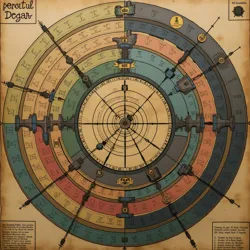Theory of Perpetual Decay
 A theoretical model illustrating the cyclic nature of perpetual decay as proposed by the Meridian Institute
A theoretical model illustrating the cyclic nature of perpetual decay as proposed by the Meridian InstituteThe Theory of Perpetual Decay is a fundamental magical-scientific framework that attempts to explain the paradoxical nature of undying corruption and related phenomena of sustained deterioration. First proposed by Archmagister Valencia Doomweaver in the aftermath of the Month of Endless Rot, this theory revolutionized our understanding of how matter can exist in states of continuous decomposition without reaching terminal entropy.
Fundamental Principles
The core premise of the Theory of Perpetual Decay rests on the concept of "entropic recursion," wherein matter enters a self-sustaining cycle of deterioration that feeds back into itself. Unlike normal decay processes that proceed linearly toward maximum entropy, perpetual decay creates what researchers at the Meridian Institute of Chromatic Sciences term a "decay loop." This phenomenon occurs when void energies interact with conventional matter in specific ways, creating a paradoxical state where the energy released by decomposition is immediately reabsorbed to fuel continued breakdown.
The theory identifies three primary components necessary for perpetual decay to manifest: an initial source of void energy, a suitable material substrate, and what is termed the "persistence catalyst." This catalyst, often derived from crystallized silence or similar void-touched substances, serves to stabilize the decay loop and prevent its natural termination. The interaction between these elements creates what is known as a Doomweaver Field, named after the theory's originator.
Mathematical Framework
The mathematical underpinnings of perpetual decay were first formalized in the Equations of Endless Entropy, a complex system of magical formulae that describe how matter can maintain a state of constant decomposition. These equations demonstrate that under specific conditions, the normal laws of thermodynamics can be suspended through the introduction of void energies, creating localized zones where decay becomes self-sustaining.
The key mathematical relationship, known as the Doomweaver Constant, expresses the precise ratio of void energy to material mass required to maintain perpetual decay. This relationship has proven crucial in understanding both Voidure Black and various applications of void realm manifestation, as it helps explain how matter can exist in states that seemingly violate conventional physical laws.
Applications in Chromatic Sciences
 Standard apparatus used for measuring perpetual decay fields at the Academy of Spectral Studies
Standard apparatus used for measuring perpetual decay fields at the Academy of Spectral StudiesThe Theory of Perpetual Decay has found numerous applications within the field of chromatic manipulation, particularly in understanding how certain pigments and materials can maintain their properties indefinitely. The Academy of Spectral Studies has used the theory's principles to develop new methods of color preservation, though these techniques are strictly regulated due to their similarity to forbidden preservation methods.
Researchers at the Guild of Systematic Thaumaturgy have successfully applied the theory to create controlled environments for studying long-term magical effects. These "decay chambers" provide valuable insights into how various substances interact with void energies over extended periods, though their operation requires careful oversight to prevent uncontrolled spread of decay effects.
Relationship to Undying Corruption
The Theory of Perpetual Decay provides the theoretical foundation for understanding how undying corruption functions at a fundamental level. By explaining the mechanisms through which matter can maintain a state of endless deterioration, the theory has helped researchers develop safer containment methods and identify potential countermeasures against uncontrolled corruption spread.
The theory's predictions about the behavior of corrupted matter have been repeatedly verified through careful observation, particularly during the controlled experiments conducted under the supervision of the Department of Chromatic Containment. These studies have revealed that the purple-black coloration characteristic of undying corruption is a direct result of the decay loop's interaction with ambient light, creating what is termed "entropic chromatic distortion."
Theoretical Implications
The implications of the Theory of Perpetual Decay extend far beyond its immediate applications in chromatic science. Its fundamental principles have led to new understanding of how temporal stasis fields function and have contributed to advanced theories about the nature of extra-dimensional space. The theory suggests that what we perceive as decay may be part of a larger cycle of energy transformation that connects our reality with the fundamental void.
Dr. Elowen Brightweave has proposed that perpetual decay may represent a naturally occurring phenomenon that has been artificially stabilized through magical means. This hypothesis, known as the Natural Decay Paradigm, suggests that similar processes might occur spontaneously in regions of space where void energies naturally accumulate.
Controversies and Criticisms
Despite its widespread acceptance, the Theory of Perpetual Decay has faced criticism from various quarters. Some scholars, particularly those affiliated with the Order of the Eternal Void, argue that the theory fails to account for certain metaphysical aspects of decay processes. Others point to apparent inconsistencies in how the theory explains the interaction between void energies and living tissue.
The most significant criticism comes from adherents of Classical Entropy Theory, who maintain that any form of perpetual decay must violate fundamental laws of nature. However, proponents of the theory counter that the introduction of void energies fundamentally alters the rules governing entropy, making such perpetual processes possible within carefully defined parameters.
Modern Research Directions
Current research into perpetual decay focuses on several key areas, including the development of more precise measurement techniques for decay fields and investigation of potential applications in waste management and material preservation. The International Council of Chromatic Control maintains strict oversight of all such research, particularly following the establishment of the Darkness Protocols.
See Also
- Entropy Manipulation Theory
- Void Energy Dynamics
- Principles of Chromatic Decay
References
- "Fundamentals of Perpetual Decay" - Archmagister Valencia Doomweaver
- "Modern Applications of Decay Theory in Chromatic Science" - Meridian Institute Press
- "Theoretical Foundations of Void Energy Interaction" - Academy of Spectral Studies